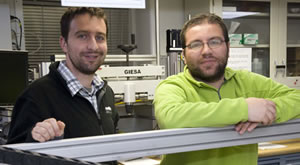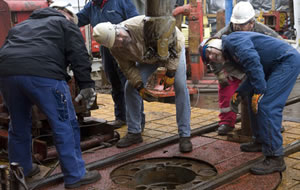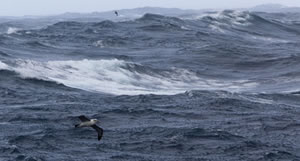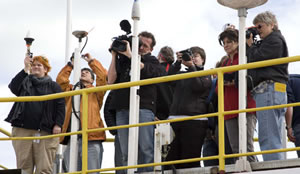IODP Expedition 318
Wilkes Land Glacial History
Daily Science Report for 31 January 2010
LOCATION: Site U1356 (WLRIS-07A; 63° 18.6139'S, 135° 59.9397'E; Water Depth 4003 mbrf)
SCIENCE UPDATE: RCB Cores U1356A-93R to -103R penetrated from 876.6 to 9776 mbsf and recovered 37.3 m (37%). Cores contain Eocene silty claystone, claystone, sandstone; some intervals have common clasts and distorted bedding. Intervals of silty claystone are greenish-grey with extensive bioturbation;. Appearance by Sun today was enjoyed by many; winds up to 15 knots, swells up to 8 feet, and temperature of 4°C.
Daily Science Report for 30 January 2010
LOCATION: Site U1356 (WLRIS-07A; 63° 18.6139'S, 135° 59.9397'E; Water Depth 4003 mbrf)
SCIENCE UPDATE: RCB Cores U1356A-84R to -92R penetrated from 795.1to 876.6 mbsf and recovered 53.9 m (66%). Cores dominated by Oligocene to late Eocene silty claystone and claystone with limited intervals of limestone, calcareous claystone, and sandy mudstone. Winds up to 8 knots, swells up to 10 feet, and temperature of 4°C.
Daily Science Report for 29 January 2010
 LOCATION: Site U1356 (WLRIS-07A; 63° 18.6139'S, 135° 59.9397'E; Water Depth 4003 mbrf)
LOCATION: Site U1356 (WLRIS-07A; 63° 18.6139'S, 135° 59.9397'E; Water Depth 4003 mbrf)
SCIENCE UPDATE: RCB Cores U1356A-76R to 83R penetrated from 718.2 to 795.1 mbsf and recovered 31.2 m (41%); average rate of penetration is 7.2 m/hr. Core recovered Oligocene(?) silty claystone, claystone and nannofossil-bearing claystone; deformed bedding, flow structures and clasts in Core 76R are a mass flow deposit. Observed/tracked a ~40 m-high, 110-m long iceberg, but it did not impact operations. Winds up to 8 knots and swells up to 10 feet.
Daily Science Report for 28 January 2010
LOCATION: Site U1356 (WLRIS-07A; 63° 18.6139'S, 135° 59.9397'E; Water Depth 3981 mbrf)
SCIENCE UPDATE: RCB Cores U1356A-66R to 75R penetrated from 631.9 to 718.2 mbsf and recovered 51.4 m (60%); average rate of penetration is 8.8 m/hr. Cores recovered early(?) Miocene silty claystone, claystone, clay-rich limestone, nannofossil-bearing claystone; observe dispersed clasts of diverse lithologies. Core 75R contains a mass-flow deposit that exhibits contorted bedding, flow structures and clasts. Winds up to 27 knots, swells up to 10 feet.
Daily Science Report for 27 January 2010
LOCATION: Site U1356 (WLRIS-07A; 63° 18.6139'S, 135° 59.9397'E; Water Depth 3981 mbrf)
SCIENCE UPDATE: RCB Cores U1356A-57R to 66R penetrated from 535.8 to 631.9 mbsf and recovered 19.5 m (20%); average rate of penetration is 12.4 m/hr. Cores recovered early(?) Miocene silty claystone, claystone, diamictite, nannofossil-rich limestone. Winds up to 30 knots and air temperature of 3°C make for sub-freezing wind chills; seas up to 10 feet.
Daily Science Report for 26 January 2010
LOCATION: Site U1356 (WLRIS-07A; 63° 18.6139'S, 135° 59.9397'E; Water Depth 3981 mbrf)
SCIENCE UPDATE: RCB Cores U1356A-48R to 56R penetrated from 449.9 to 535.8 mbsf and recovered 17.9 m (21%); average rate of penetration is 9.6 m/hr. Cores recovered are early(?) Miocene sandy-muddy diamictites, claystone/silty claystone with clasts, some limited intervals of interbedded nannofossil-rich claystone and micritic limestone; igneous and metamorphic clasts are frequently observed. Environmental conditions remain good (~4°C temperatures, winds <16 knots, and swells <8 ft), but winds are forecast to increase to 30 knots with seas ~15 feet.
Daily Science Report for 25 January 2010
LOCATION: Site U1356 (WLRIS-07A; 63° 18.6139'S, 135° 59.9397'E; Water Depth 3981 mbrf)
SCIENCE UPDATE: RCB Cores U1356A-35R to 47R penetrated from 325.5 to 449.9 mbsf and recovered 32.3 m (26%). Cores recovered are middle Miocene, diatom-bearing silty clay and clay to claystone; observing presence of bioturbation, occasional thin silt lamina, and evidence of opal alteration. Environmental conditions remain good with ~2°C temperatures, winds <6 knots, and swells <8 ft.
Daily Science Report for 24 January 2010
LOCATION: Site U1356 (WLRIS-07A; 63° 18.6139'S, 135° 59.9397'E; Water Depth 3981 mbrf)
SCIENCE UPDATE: RCB Cores U1356A-17R to 34R penetrated from 153 to 325.5 mbsf and recovered 45.6 m (26%). Cores are dominantly middle Miocene diatom-bearing silty clay with commonly occurring granule to pebble sized clasts of various igneous and metamorphic lithologies. Environmental conditions remain remarkably good with ~1°C temperatures, winds <12 knots, and swells <8 ft.
Daily Science Report for 23 January 2010
LOCATION: On location at Site U1356 (WLRIS-07A; 63° 18.6139'S, 135° 59.9397'E; Water Depth 3981 mbrf)
SCIENCE UPDATE: RCB Cores U1356A-1R to 16R penetrated from 0 to 153 mbsf and recovered 40.8 m (27%). Cores recovered late to middle Miocene diatom ooze with varying amounts of silty, clay, and dispersed pebble to gravel-sized clasts of diverse lithologies. Environmental conditions are quite good with ~3°C temperatures, winds <7 knots, and swells <8 ft.
Daily Science Report for 22 January 2010
LOCATION: End Site U1355 (WLRIS-06A; 63° 50.470'S, 138° 49.427'E)
Transit to and arrive Site U1356 (WLRIS-07A; 63° 18.6139'S, 135° 59.9397'E)
SCIENCE UPDATE: Once the drill string and seafloor beacon were recovered and the thrusters raised, we departed for Site U1356 (WLRIS-07A) at 0600. One iceberg was observed on radar during the transit. At 1345, we arrived at Site U1356, assembled the RCB bottom hole assembly and lowered it to the seafloor in preparation to start coring.
Daily Science Report for 21 January 2010
 LOCATION: Site U1355 (Proposed Site WLRIS-06A; 63° 50.470'S, 138° 49.427'E)
LOCATION: Site U1355 (Proposed Site WLRIS-06A; 63° 50.470'S, 138° 49.427'E)
SCIENCE UPDATE: RCB coring in Hole U1355A penetrated from 0 to 31.7 mbsf and recovered 14.95 m (47%). Cores recovered late Quaternary coarse sands and gravels (composed of granitic and meta-sediments). We stopped coring due to unstable hole conditions and started retrieving the drill string. Once we recover the drill sting and seafloor beacon we'll move to Site WLRIS-07A (82 nmi to the WNW). This is our only remaining viable site where we can obtain a distal Eocene/Oligocene section. Based on remote sensing data and information from a research vessel near shelf sites, we decided to postpone returning to the shelf sites at this time.
Daily Science Report for 20 January 2010
LOCATION: Site U1355 (Proposed Site WLRIS-06A; 63° 50.468'S, 138° 49.418'E)
SCIENCE UPDATE: Finished lowering drill string to seafloor and made two attempts to core seafloor with APC. Apparently the APC encountered a hard seafloor surface each time and resulted in broken/bent APC core barrels. We decided to switch to RCB coring and spent the rest of the day retrieving the drill string. No ice in area; wind <15 knots, swells up to 10 feet; overcast with rain and snow; air and water temperature are 3°C.
Daily Science Report for 19 January 2010
LOCATION: Arrived at Site U1355 (Proposed Site WLRIS-06A; 63° 50.482'S, 138° 49.398'E)
SCIENCE UPDATE: Scientists attended an orientation to Site WLRIS-06A science objectives and seismic data. All scientists and technical staff more than ready for core! Arrived on site just before 1100 and began assembling drill string. Wind and seas relatively calm (<15 knots; <10 feet); Air temperature is 4°C and water is 3.5°C.
Daily Science Report for 18 January 2010
LOCATION: In Transit to Proposed Site WLRIS-06A (alternate for WLRIS-02A) (65° 8.5'S, 140° 15.6'E)
SCIENCE UPDATE: Scientists attended a presentation on the upcoming drill site and another on an introduction to downhole logging. We continued our transit to proposed Site WLRSHE-09B on the Antarctic continental shelf. We had to continually adjust speed to changing visibility while monitoring icebergs on the radar. Once the fog cleared, we were able to see many icebergs of various shapes and sizes. We continued to approach the site at slow speed when the weather began to deteriorate in the afternoon – winds up to 35 knots and snow with reduced visibility. We decided to postpone our efforts to reach WLSHE-09B until ice conditions were more favorable. We then altered course to proposed Site WLRIS-06A (63° 50.48'S, 138° 49.40'E; alternate for Site WLRIS-02A) in 3773 m of water, which was ~167 nmi to the NNW and appeared to be free of ice.
Daily Science Report for 17 January 2010
LOCATION: In Transit to Antarctica (64° 42.6'S, 145° 13.2'E)
SCIENCE UPDATE: Continue to refine shipboard sampling/analysis plans for geochemistry and paleontology. We continue to proceed toward Proposed Site WLSHE-09B in relatively calm seas and wind with dense fog occasionally reducing visibility to <1/8th of a mile. A large iceberg was observed on radar at 0440 hr at 17 nmi. The latest satellite image indicates that a large tongue of ice is preventing a direct route to Site WLSHE-09B. Everyone involved in operations met this afternoon to decide how we will proceed (Captain, OIM, DP Operator, Weather and Ice Observers, Operations Superintendent, Loggers, Lab Officer, and Chief Scientists). We reviewed ice/weather conditions, operations, and science priorities. We decided to still to try to get to WLSHE-09B. So, we will sail southwest along the northern edge of the ice tongue and approach the site from the southwest if ice coverage allows.
Daily Science Report for 16 January 2010
LOCATION: In Transit to Antarctica (61° 49.1'S, 151° 8.7'E)
SCIENCE UPDATE: Operations Superintendent and Core Techs gave scientists an introduction to drilling operations and coring tools. Continue to refine shipboard sampling/analysis plans for paleomagnetics and physical properties. First iceberg observed (radar/visually) at distance of 5 nm with estimated length of 300 feet and height of 50 feet; few growlers in vicinity as well. Ship reduced speed periodically due to reduced visibility due to fog/mist. Air temperature ~2°C; water temperature dropped from 6° to 0°C during the day. Winds 10-12 knots with swells up to 12 feet. First penguins sited. ETA in area of first site is mid-morning of 18 January.
Daily Science Report for 15 January 2010
LOCATION: In Transit to Antarctica (58° 44.9'S, 156° 8.7'E)
 SCIENCE UPDATE: Scientists attended presentation on changing ice volumes from the Eocene to early Miocene. Lab groups continue to learn labs and plan workflow. Chief scientists gave presentation on expedition science objectives to ship, catering, and USIO staff. Shipboard sampling plans being refined. Today's weather improved with winds up to 25 knots and swells up to 12 feet – so we were able to cover ~230 nmi at ~10 knots. Air temperature is 5°C; water temperature is 7°C. Estimated arrival in vicinity of our first site (WLSHE-09B) is afternoon of 18 January.
SCIENCE UPDATE: Scientists attended presentation on changing ice volumes from the Eocene to early Miocene. Lab groups continue to learn labs and plan workflow. Chief scientists gave presentation on expedition science objectives to ship, catering, and USIO staff. Shipboard sampling plans being refined. Today's weather improved with winds up to 25 knots and swells up to 12 feet – so we were able to cover ~230 nmi at ~10 knots. Air temperature is 5°C; water temperature is 7°C. Estimated arrival in vicinity of our first site (WLSHE-09B) is afternoon of 18 January.
Daily Science Report for 14 January 2010
LOCATION: In Transit to Antarctica (55° 36.5'S, 160° 11.2'E)
SCIENCE UPDATE: Scientists attended presentation "Paleogene temperatures of the Southwest Pacific Ocean and its relation to dinoflagellate cyst biogeography." Core Description and Paleontology groups met to refine work flow and data acquisition. Chief scientists, Operations Superintendent, Logging Scientists, and Lab Officer met to discuss coring and logging operations for our first site. Scientists are finalizing their shipboard methods. The first few hours of the day we had to maintain an altered course of 275° at reduced speed to wait for the weather to improve; remainder of the day we were able to resume transit to our first site at a speed of about 6 knots. Winds were 20 to 45 knots with seas up to 20 feet but improved throughout the day.
Daily Science Report for 13 January 2010
LOCATION: In Transit to Antarctica
SCIENCE UPDATE: Scientists attended presentations on the "Neogene stability of the Wilkes Land ice margin based on ice-rafted debris" as well as "Mining Past Millennia for Secrets about Climate Change—Adventures from the Tropics to the Poles". Strong winds (up to 60 knots) and large swells (maximum ship roll of 13°) led us to reduce speed and alter course.
Daily Science Report for 12 January 2010
LOCATION: In Transit to Antarctica
SCIENCE UPDATE: Scientists attended presentations on Eocene to late
Neogene history of the East Antarctic Ice Sheet from ANDRILL-1b and
Eocene to Oligocene cooling. Core flow and laboratory data acquisition
practice were conducted on practice cores. Reduced speed late in the day to
avoid intersecting low pressure system ahead of us; barometer falling
and wind/seas increase as we approach outer edge of system.
Daily Science Report for 11 January 2010
LOCATION: In Transit to Antarctica
SCIENCE UPDATE: Scientists attended a presentation on late Miocene to Pleistocene history of the West Antarctic Ice Sheet from ANDRILL-1b. The ice observer and weather forecaster made a presentation this afternoon regarding the kind of ice and weather we can expect during the expedition. Curator provided core handling and sampling training. Ship traveled 205 nmi at 8.5 nmi/hr in moderate to rough seas up to 25 feet with pitch and roll up to 4°. Crew continues to prepare for extreme weather operations.
Daily Science Report for 10 January 2010
LOCATION: In Transit to Antarctica
SCIENCE UPDATE: Held meeting to discuss extensive and wide-ranging
education and outreach activities being implemented for the Wilkes Land
Expedition. Conducted a fire and boat drill (including donning survival
suits) and held specific lab safety training for palynological sample
preparation. Laboratory teams worked through instruments and methods.
Vessel motion increased once we passed south of New Zealand.
Daily Science Report for 9 January 2010
 LOCATION: In Transit to Antarctica
LOCATION: In Transit to Antarctica
SCIENCE UPDATE: Port call activities were completed and we departed Wellington, New Zealand at 1045 AM. We are heading SSW off the east coast of the South Island in calm seas. Preliminary analysis of ice coverage appears promising for our first site (WLRIS-09B). Weather in the region is currently 0.2°C with winds from the ESE increasing to 35-40 knots; cloudy with occasional snow or sleet. We estimate that we'll arrive at our first site ~noon on 17 January. Science participants met to discuss individual research plans.
Daily Science Report for 8 January 2010
LOCATION: Aotea Quay, Wellington, New Zealand
SCIENCE UPDATE: Laboratory safety orientation was provided for entire
science party. Initiated discussion of research planning (sampling and
data). Chief Scientists met with operations staff to discuss weather and
ice monitoring; reviewed initial ice and weather data/forecasts. Ship
moved forward 100 feet to enable re-fueling. Ship crew and USIO staff
securing for transit. Tour conducted for visiting NSF, USA
Appropriations Committee staff, and US Embassy staff. Scheduled for
departure tomorrow, 9 Jan. Afternoon was free for scientists' last day on
land.
Daily Science Report for 7 January 2010
LOCATION: Aotea Quay, Wellington, New Zealand
SCIENCE UPDATE: Continued with scientist orientation to laboratories,
what we plan to accomplish during the expedition and how we will do it.
Presentation on Adelie Drift science objectives was given. Captain held
initial introduction and safety meeting. New Zealand customs and
immigration processed all participants.
Daily Science Report for 6 January 2010
LOCATION: Aotea Quay, Wellington, New Zealand
SCIENCE UPDATE: Initiated shipboard orientation with scientist and
technical staff introductions. Presentations included expedition science
objectives by the chief scientists, life on board the JOIDES Resolution,
computer resources, and core description software. Lab tours were conducted
for all scientists. Loading of drilling mud has been completed. Walls to minimize
winds on the catwalk were installed. Ship tours were conducted. Science
party attended reception at University of Victoria with talks from both
Canterbury and Wilkes expedition scientists.
Daily Science Report for 5 January 2010
LOCATION: Aotea Quay, Wellington, New Zealand
SCIENCE UPDATE: Scientific participants moved onto the ship and we
continued preparing for their orientation. Installed computers for
weather and ice observers. Press conference and tours for press were
conducted. Loaded arriving shipments, drilling mud, and fresh produce.
Thruster repairs completed. Scheduled for on time departure early 9 Jan.
Daily Science Report for 4 January 2010
LOCATION: Aotea Quay, Wellington, New Zealand
SCIENCE UPDATE: The first day of the Wilkes Land Expedition port call consisted of the USIO crew change, debriefing of off-going scientists and technical staff, preparing for arrival of the Wilkes Land Expedition scientific participants, offloading Canterbury Expedition surface shipments, and loading arriving air shipments. Chief Scientists, Ice Observer, and Weather Forecaster moved on board. Prepared for Tuesday’s press conference and tours. Required maintenance for one thruster progressing well and is ahead of schedule.
